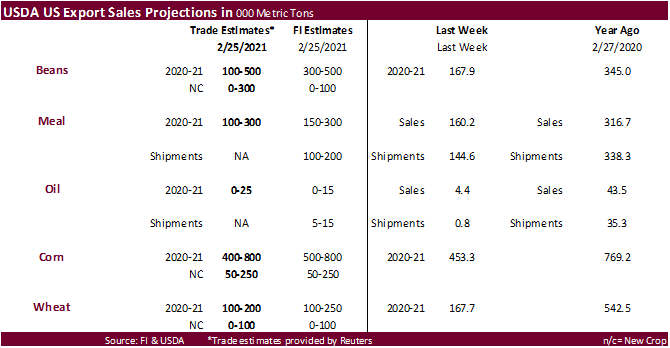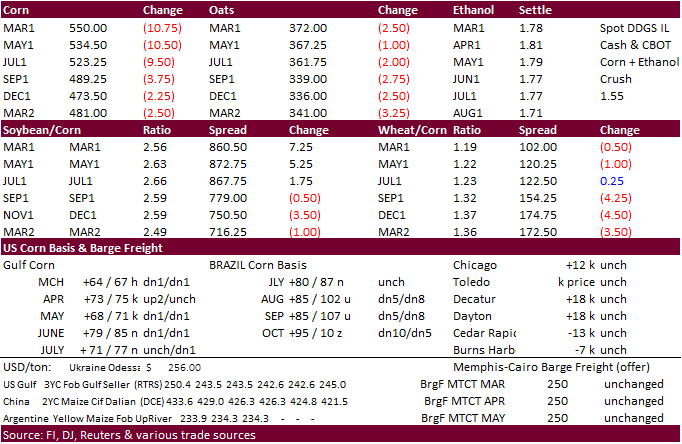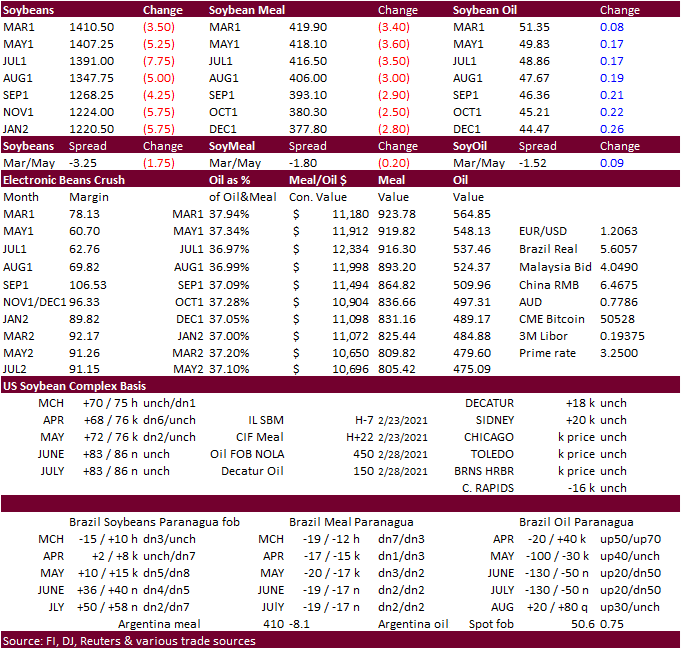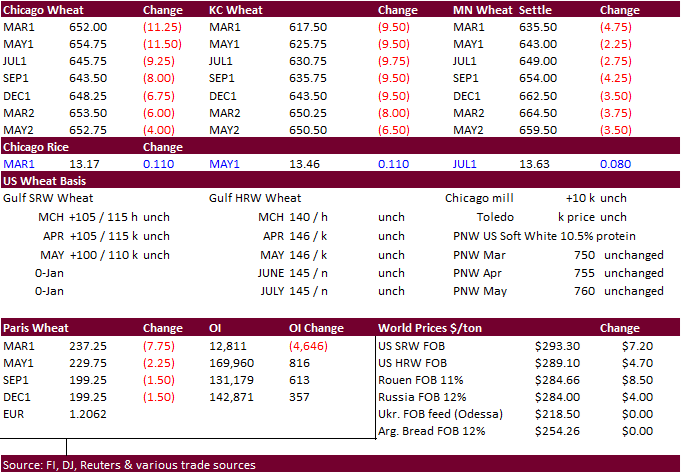PDF Attached
Weaker Brazilian real weighed on soybeans and corn in the US as South American exports become more attractive. Wheat fell on uninspiring demand prospects for US exports. Argentina weather watched as hot and dry conditions persist.


WEATHER THAT MATTERS MOST TODAY
- U.S. hard red winter wheat areas are still expecting rain Thursday into Friday with areas from eastern Colorado through central Kansas to north-central Oklahoma wettest
- Rainfall of 0.20 to 0.80 inch will be common with a few totals to 1.25 inches or more possible in a part of western and south-central Kansas and north-central Oklahoma
- 06z GFS model run today was too wet in hard red winter wheat areas for late next week and again March 14-16
- Both of these storm systems were too intense on the latest model run
- However, there will be opportunities for some precipitation in the region during each period
- The southwestern high Plains region will receive only light and somewhat sporadic precipitation while the greater amounts of moisture is possible in northern and eastern crop areas
- U.S. central Plains wheat will benefit from the next ten days of moisture and sunshine, but there will still be need for more precipitation especially in the southwest where rainfall will likely be lightest
- Moisture and mild temperatures is needed to induce new tillering and to stimulate some crop recovery and improvement in production potentials after dryness last autumn and the bitter cold event of February
- U.S. northern Plains and extreme southeastern parts of Canada’s Prairies will have a good opportunity for some needed moisture Monday night into Wednesday morning
- Moisture totals will vary from 0.10 to 0.50 inch with a few amounts to nearly 1.00 inch possible
- Minnesota and far southeastern Manitoba will be wettest
- The precipitation will be most welcome in drought-stricken areas of the northwestern Plains and southern Canada’s Prairies, but much more precipitation will be needed to make a more serious dent in the drought
- Temperatures will be unusually warm in these areas through the weekend
- Argentina’s rainfall outlook is not very good and many areas in the nation will experience net drying over the coming week, despite some periodic showers of varying significance
- Most of the precipitation will not counter evaporation for a while
- World Weather, Inc. sees some changes in the upper air wind pattern evolving in the second week of the forecast that may help to bring a little better opportunity for rain periodically
- But, confidence is still low on how much relief might occur
- Crop stress will remain a serious concern for many summer crops in Argentina until a generalized soaking rain evolves
- Temperatures will continue too warm to hot to allow scattered showers of light intensity to change the drying trend during this next seven days
- Some cooling is expected next week, but temperatures will remain above average
- Brazil’s weather has not changed overnight and for the next two weeks most of the nation will be impacted by alternating periods of rain and sunshine
- The moisture will be mostly near normal except in the northeast where drier than usual conditions are expected
- A few locations in southern Rio Grande do Sul may also receive a more limited amount of rain
- Field progress advanced favorably in some areas last week with 25% of the soybean harvest complete compared to 40% a year earlier
- That was an advancement of 10% over the previous week
- Mato Grosso had 52% of its soybeans harvested compared to 84% done last year
- Greater rain frequency in this current week will slow field progress again
- Flooding continues, although is beginning to ease today in Kentucky and neighboring areas of Tennessee and West Virginia following excessive rainfall during the weekend
- The region will not see much additional precipitation through the early part of next week resulting in improving conditions
- Much of the U.S. Midwest will be dry into early next week and what little moisture occurs in the north is not likely to create a problem as the region’s snow cover continues to melt
- Rain in the southeastern U.S. Tuesday was greatest from southeastern Mississippi to southern Georgia and far northern Florida where 0.60 to 2.20 inches resulted through midnight CST
- U.S. southeastern states will see less frequent and less significant rain in the coming week resulting in needed drying and some spring planting
- U.S. weather will become more active next week with three waves of precipitation to move across the Midwest that will also impact “parts” of the Great Plains, northern Delta and northern portions of the southeastern states
- One storm will occur during the early to middle part of next week
- Another system is expected in the following weekend
- A third storm will impact these areas March 14-17
- Sufficient amounts of moisture will occur to have the ground saturated during much of the period and there may be local areas of flooding
- Unseasonably warm temperatures in the central U.S. will send temperatures into the 50s and 60s Fahrenheit later this week as far north as Montana, southwestern North Dakota and South Dakota
- Normal highs in the northern Plains should be in the 30s and 40s followed by lows in the teens and 20s
- The warm up in the northern Plains should set the stage for some needed moisture to fall when colder weather returns next week
- Drought remains a serious concern across the Dakotas, eastern Montana and areas north into the Canada Prairies
- Temperatures in the 50s and lower 60s might also reach into southern Saskatchewan and southern Alberta, Canada
- Unusual warmth in the central Plains and light precipitation may also stimulate some new wheat development soon
- Soil temperatures are already rising and some greening has begun in the southern Plains
- Southern U.S. spring planting is getting off to a slow start in southern Texas due to dryness in unirrigated areas, but it has begun
- Slow planting has also occurred near the central Gulf of Mexico coast from Louisiana to northern Florida and Georgia because of wet fields, but some fieldwork has likely evolved recently
- Some wet field and rain delay is expected in the lower Delta and southeastern states for a little while this week, but conditions will soon improve for planting
- Canada’s central and southwestern Prairies will remain drier than usual through the next ten days
- Precipitation elsewhere is expected to be infrequent and light limiting the potential for increasing soil moisture
- Temperatures will be near to above average
- Southeast Canada will experience a seasonable mix of precipitation and sunshine with temperatures a little cooler than usual
- North Africa rainfall will improve this week with many areas from northern Morocco through northern Tunisia getting rain at one time or another lifting topsoil moisture for future crop development
- Showers Tuesday were erratic and light and mostly confined to northeastern Morocco
- Winter crops are semi-dormant, but expected to resume development soon
- Ivory Coast, Ghana, Benin and southern Nigeria will experience a boost in rainfall for a while late this week into next week favoring coffee and cocoa flowering
- East-central Africa rainfall will continue greatest in Tanzania this week and probably next week, as well
- A more erratic and light precipitation pattern is expected elsewhere with net drying in Ethiopia, northern Uganda and in a few southwestern Kenya locations
- South Africa will experience an erratic rainfall pattern through the next two weeks with temperatures mostly in a seasonable range with a slight warmer bias in the west
- Showers will be greatest in Natal and Eastern Cape
- Net drying will occur in many other areas
- Summer crop conditions will remain favorably rated, although there will be a growing need for showers by mid-March
- India was mostly dry Tuesday
- Very little rainfall is expected over the next week to ten days and temperatures will be seasonably warm
- Showers will occur in the far north, extreme south and far east
- Some mild crop stress is expected resulting in some minor yield loss
- Rain is needed to support the best potential yields before filling ends this month
- China reported most dry conditions Tuesday, although a few showers occurred in the Yangtze River Basin
- Temperatures were seasonable
- China weather over the coming week will include seasonably warm temperatures and near to above average precipitation in the south
- The greatest precipitation relative to normal will be in the Yangtze River Basin and areas to the south
- Rainfall near and south of the Yangtze River will vary from 1.00 to more than 5.00 inches except in the coastal provinces where amounts will be less than 1.00 inch
- Local flooding is possible
- Yunnan will remain dry and produces 3% of the corn crop and quite a bit of rice and sugarcane
- Australia precipitation Tuesday was minimal except in Western Australia where winter crop areas received another 0.10 to 1.77 inches of rain with local totals over 3.00 inches;
- The moisture improved soil conditions, but no planting is expected prior to late April
- Australia weather in the coming week is expected to bring on restricted amounts of precipitation in key sorghum, cotton and other summer crop areas in the east while temperatures are seasonable
- A few showers are expected, but resulting rainfall will be erratic and light
- Mexico drought conditions are still prevailing, although the impact on winter crops is low due to irrigation
- Water supply is low in some areas and a notable improvement in rainfall is needed, but not very likely
- Dryland winter crops are stressed and will yield poorly
- Freeze damage is common in northern parts of the nation due to a couple of cold surges this winter
- Rain in the coming week will be mostly confined to the east coast and temperatures will be seasonable with a slight warmer bias in the driest areas
- Central America precipitation will continue greatest along the Caribbean Coast and in Guatemala while the Pacific Coast is relatively dry
- Southeast Asia rainfall will occur relatively normally over the next two weeks
- Mainland areas will experience few showers periodically in the next week to ten days
- The resulting rainfall will be sporadic and light with net drying probably continuing in many areas for a while longer
- Philippines rainfall will be scattered and mostly light to moderate until late next week when a boost in precipitation is expected
- Indonesia and Malaysia weather during the next two weeks will bring rain to most crop areas maintaining a very good outlook for crop development
- A boost in precipitation is expected and will be welcome
- Sumatra, Peninsular Malaysia and western parts of Borneo have been drying out recently and greater rain is needed especially in Peninsular Malaysia
- New Zealand weather over the next ten days will include a mix of sunshine and rain while temperatures are a little cooler than usual
- Southern Oscillation Index has been falling and was at +9.71 this morning. The index is expected to continue to fall notably over the next several days
- Warming in Europe and the western CIS has been melting some snow
- Snow-free conditions are present today in Russia’s Southern Region, much of Ukraine and in many areas across Europe to the west of Ukraine and eastern Poland
- There is no threatening cold in any winter crop region for the next ten days
- Europe weather will be tranquil over the coming week with only brief periods of light precipitation and temperatures close to normal
- A boost in precipitation is expected March 11-17
- Western CIS temperatures will be seasonable with a slight warmer bias this week in the south and while a little cooler than usual in the north
- Precipitation will remain periodic keeping the region plenty moist in snow free areas and some significant runoff is expected in areas warm enough for melting snow
- Cooling next week will bring some threatening cold air into the western CIS, but snow cover will adequately protect most crops
Source: World Weather Inc. and FI
Bloomberg Ag Calendar
Wednesday, March 3:
- EIA weekly U.S. ethanol inventories, production
- ANZ Commodity Price
- Brazil’s Unica to release sugar production, cane crush data
Thursday, March 4:
- FAO World Food Price Index, grains supply and demand reports
- USDA weekly crop net‐export sales for corn, soybeans, wheat, cotton, pork, beef, 8:30am
- Port of Rouen data on French grain exports
- U.S. National Coffee Association hosts annual convention (virtual), March 4‐5
Friday, March 5:
- ICE Futures Europe weekly commitments of traders report (6:30pm London)
- CFTC commitments of traders weekly report on positions for various U.S. futures and options, 3:30pm
- Malaysia’s March 1‐5 palm oil export data
- FranceAgriMer weekly update on crop conditions
- China’s CNGOIC to publish supply and demand reports on commodities such as corn and soybeans

Canada Building Permits (M/M): 8.2% (est 2.5%, prev -4.1%)
Corn
- Corn futures closed lower in profit-taking trade. Although near the highs and in the wake of the “Supercycle” headline, we are seeing the inability to hold a rally and a “risk-off” feel of money flow in ags. We have been witnessing a rangebound trade since the February WASDE report and expect it to continue until we get the report on March 9th.
- Following the WASDE report, focus will shift dominate the acreage discussion and planting timelines.
- Basis for corn rose biased the ECB as corn supply tightens.
- Funds were net sellers of 23,000 corn contracts on the session.
- Weekly ethanol production rebounded a more than expected 191,00 barrels (Bloomberg est. +162) and the draw in stocks slid 360,000 barrels to 22.425 million barrels. At 849,000 barrels per day week ending February 26, this will not favor USDA’s 4.950 billion bushel corn usage unless we see +925 thousand per day rebound by mid-March.
Export developments.
Algeria seeks 30,000 tons of corn, optional origin, on March 4, for shipment by April 15.

Brazilian Real Currency (USD/BRL)


Updated 3/1/21
May corn is seen in a $5.20 and $5.75 range.
July is seen in a $5.00 and $6.00 range.
December corn is seen in a $3.85-$5.50 range.
- Soybeans finished lower today on the weaker Brazilian real boosting South American exports prospects. Weather in South America is bullish with the wet weather in Brazil delaying fieldwork while the hot and dry Argentine weather is wreaking havoc on the crops.
- Underpinning the soybean complex are the firm prices in China on the Dalian Exchange and the tight US carryout.
- Funds were net sellers of 5,000 soybean contracts and 3,000 soybean meal contracts and net buyers of 1,000 beanoil contracts.
- ICE canola rose for the fourth day on extremely tight supplies. The strength in global vegoils was also noted with firmer closes in EU rapeseed and Malaysian palm oil.

Updated 3/1/21
May soybeans are seen in a $13.50 and $15.00 range.
May soymeal is seen in a $400 and $460 range.
May soybean oil is seen in a 47.00 and 52.00 cent range.
- Wheat dropped on weak demand for US exports and technical selling against the 50-day MA in WK1.
- The stronger USD also weighed on the wheat markets. We do think price will find demand if we are to break below $6.50/bu.
- Funds were net sellers of 8,000 net wheat contracts on the session.
- EU May milling wheat was down 2.25 euros at 229.75 euros.
Export Developments.
- Jordan passed on 120,000 tons of wheat.
- Results awaited: Algeria seeks 50,000 tons durum wheat, valid until March 4, for shipment between April 1-15 and April 16-30.
- Results awaited: Iran’s SLAL seeks up to 400,000 tons of animal feed barley on Wednesday, March 3, for shipment between March 10 and April 10.
- Japan bought 82,937 tons of milling wheat from the United States and Canada for April 21‐May 3 shipment. Original details as follows:

- The Philippines seeks 145,000 tons of milling wheat on March 4 for April and June shipment.
- Taiwan seeks 100,410 tons of wheat form the US on March 4 for April 25-May 9 shipment, and May 12-May 26 shipment (2 consignments).
Rice/Other
· South Korea’s Agro-Fisheries & Food Trade Corp. seeks 38,889 tons of rice from the United States and China, part arrival in South Korea around Sept. 30 from the US. Another 16,667 tons of non-glutinous short grain brown rice from China is sought for arrival around June 30.
· Syria seeks 25,000 tons of white rice on March 29, from China or Egypt.


Updated 3/1/21
May Chicago wheat is seen in a $6.25‐$6.90 range.
May KC wheat is seen in a $5.30‐$6.75 range.
May MN wheat is seen in a $6.20‐$6.65 range.
Terry Reilly
Senior Commodity Analyst – Grain and Oilseeds
Futures International
One Lincoln Center
18 W 140 Butterfield Rd.
Oakbrook Terrace, Il. 60181
W: 312.604.1366
ICE IM: treilly1
Skype: fi.treilly

Trading of futures, options, swaps and other derivatives is risky and is not suitable for all persons. All of these investment products are leveraged, and you can lose more than your initial deposit. Each investment product is offered only to and from jurisdictions where solicitation and sale are lawful, and in accordance with applicable laws and regulations in such jurisdiction. The information provided here should not be relied upon as a substitute for independent research before making your investment decisions. Futures International, LLC is merely providing this information for your general information and the information does not take into account any particular individual’s investment objectives, financial situation, or needs. All investors should obtain advice based on their unique situation before making any investment decision. The contents of this communication and any attachments are for informational purposes only and under no circumstances should they be construed as an offer to buy or sell, or a solicitation to buy or sell any future, option, swap or other derivative. The sources for the information and any opinions in this communication are believed to be reliable, but Futures International, LLC does not warrant or guarantee the accuracy of such information or opinions. Futures International, LLC and its principals and employees may take positions different from any positions described in this communication. Past results are not necessarily indicative of future results.
